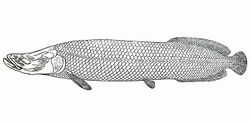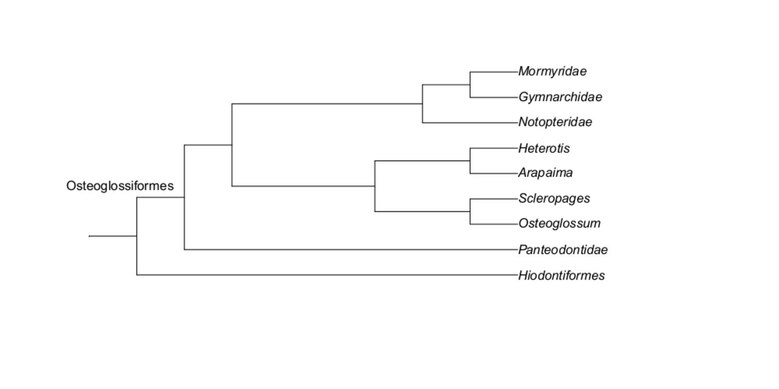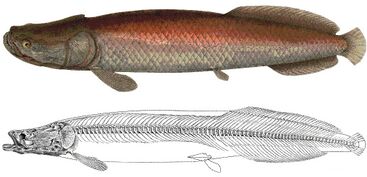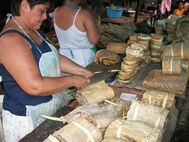Biology:Arapaimidae
| Arapaimidae | |
|---|---|

| |
| Arapaima sp. | |
| Scientific classification | |
| Domain: | Eukaryota |
| Kingdom: | Animalia |
| Phylum: | Chordata |
| Class: | Actinopterygii |
| Order: | Osteoglossiformes |
| Suborder: | Osteoglossoidei |
| Family: | Arapaimidae Bonaparte, 1846 |
| Genera[1] | |
Arapaimidae is a family of freshwater osteoglossiform (bony-tongued) fishes that includes the South American arapaimas of the Amazon and Essequibo basins and the African arowana (Heterotis niloticus) from the watersheds of the Sahelo-Sudanese region, Senegal, Gambia, and parts of Eastern Africa.[2] This family is sometimes considered to be a part of a monophyletic Osteoglossidae, including the genera Arapaima, Heterotis, Osteoglossum (South American arowana) and Scleropages (Asian arowana).[3][4]
The Arapaimidae, along with the other Osteoglossiformes, are of phylogenetic and evolutionary interest due to their trans-oceanic distribution, excellent fossil record, and position as one of the oldest living teleost lineages.[4] Economically, The type-species of the group, Arapaima gigas, is an important South American food source and charismatic representative of the region.[5] Both Arapaima and Heterotis are cultured for food in their respective countries due to their heartiness and meat, and Arapaima is a prize sport-fish, being the largest truly freshwater fish.[6]
Phylogeny and Systematics
The internal placement of the Osteoglossiformes within crown-group teleosts is contested, with competing morphological and molecular analyses placing them either as sister to all other extant teleosts, or internal to Elopimorpha and sister to the clade consisting of Otocephala and Euteleostei.[3][7]
The placement and name of the family containing Arapaima and Heterotis is also uncertain. Some include this clade in the Family Osteoglossidae with the South American and Asian arowana.[6] Others place Arapaima and Heterosis together in their own family, Arapaimidae.
Taxonomy
Arapaima taxonomy was recently revised to revalidate old names and describe a new species, proposing 6 existing species (see below) and invalidating current museum specimens. [5][8][9] However, these four proposed or reestablished species are known only from singular holotype specimens, and only that of A. mapae and A. leptostoma still currently exist. [5][8][9] Typically, all species of Arapaima described by Valenciennes, Spix, and Agassiz are referred to as A. gigas, though current taxonomy could be revised with more thorough evidence.[8] Currently, population genetic evidence supports a singular Arapaima species with two distinct genetic populations: an Amazonas population (exhibiting a pattern of isolation by distance), and an Araguaia-Tocantins basin population. [8] There is little debate that Heterotis is a monotypic genus represented by only H. niloticus.
- Family Arapaimidae (Heterotidinae) Nelson 1968 sensu Li, Grande & Wilson 1997
- Genus †Arapaimidarum [otolith]
- Genus †Heterotidinarum Nolf, Rana & Prasad 2008 [otolith]
- Genus †Thrissopterus Heckel 1856
- Genus †Chandlerichthys Grande 1986
- Genus †Laeliichthys Silva Santos 1985
- Genus †Joffrichthys Li & Wilson 1996
- Genus †Sinoglossus Su 1986
- Genus Heterotis Rüppell 1829 ex Ehrenberg 1836 (African arowana)
- H. niloticus (Cuvier, 1829)
- Genus Arapaima Müller 1843 (arapaima)
- A. gigas (Schinz, 1822)
- A. agassizii (Valenciennes, 1847)
- A. mapae (Valenciennes, 1847)
- A. leptostoma Stewart, 2013
- A. sp. incertae sedis
- A. gigas (Schinz, 1822)
Description and Biology
Description
The Arapaimidae are characterized by elongate, slender bodies with large scales and long dorsal and anal fins positioned close to a short caudal peduncle.[2][4] Pelvic fins are small and abdominal if present.[2][4] They lack chin barbels, have a glossolaryngeal (tongue) bone with teeth present, and a premaxilla fixed to the skull.[2][4] Branched caudal fin rays are less than sixteen, branchiostegal rays between three and seven, and hypurals less than 6.[2][4] Heterosis possess specialized suptrabranchial organ for concentrating and filtering small food particles.[2][7]
Biology
Both general make use of similar freshwater habitats in the respective region, with Arapaima found in the floodplains of the Amazon and Esequibo river basins of South America and Heterotis found in littoral zones of large, open rivers in all Sahelo-Sudanese basins of Africa.[10][11] Arapaima is typically a top-water fish predator, while Heterotis is a benthic mud-filterer primarily feeding on phytoplankton and small crustaceans with their suprabranchial organ. [10][11] Both groups are obligate air-breathers and nest-builders, with males guarding eggs and young. [10][11]
Evolution
A genetic study shows that the Arapaimidae (arapaimas and African arowana) diverged from Osteoglossidae about 220 million years ago, during the Late Triassic. Within Osteoglossidae, the lineage leading to the South American Osteoglossum arowanas diverged about 170 million years ago, during the Middle Jurassic. The Asian and Australian arowanas in the genus Scleropages separated about 140 million years ago, during the Early Cretaceous.[12][13]
Originally, it was thought that the breakup of Gondwana 150 – 30 million years ago was the evolutionary cause of the trans-continental distribution of the osteoglossimorphs. However, minimum ages of intercontinental clades and presence of marine forms in the fossil records imply that ancestral trans-oceanic dispersal is possible. Tests of these hypotheses are currently inconclusive as they are dependent on an a priori calibrated age of crown-group Teleostei, about which fossil and molecular evidence disagree. I.e., hypotheses do not fail only if Teleostei are of Permian origin, but molecular inferences push crown ages further back.[4][12][13][9]
Use by Humans
Both Arapaima and Heterotis are farmed in their respective regions as relatively large and hardy food-fish.[2]
Etymology
The family is names after the monotypic genus Arapaima, whose name derives from the Tupi-Guyarana indigenous name for Arapaima gigas.
References
- ↑ Froese, Rainer, and Daniel Pauly, eds. (2013). "Arapaimidae" in FishBase. August 2013 version.
- ↑ 2.0 2.1 2.2 2.3 2.4 2.5 2.6 Froese, R.; Pauly, D. (2021). "FishBase". World Wide Web electronic publication. https://www.fishbase.de/summary/FamilySummary.php?ID=628.
- ↑ 3.0 3.1 Hilton, E. J.; Lavoue, Sebastien (2018). "A review of the systematic biology of fossil and living bony-tongue fishes, Osteoglossimorpha (Actinopterygii: Teleostei)". Neotropical Ichthyology 16(3): e180031.
- ↑ 4.0 4.1 4.2 4.3 4.4 4.5 4.6 Hastings, P. A.; Walker, Jr., H. J.; Galland, G. R. (2014). Fishes: a guide to their diversity. Oakland, California: University of California Press. pp. 62-64. ISBN 978-0-520-28353-4.
- ↑ 5.0 5.1 5.2 Stewart, J. D. (2013a). "Re-description of Arapaima agassizii (Valenciennes), a rare fish from Brazil (Osteoglossimorpha: Osteoglossidae)". Copeia 2013(1): 38-51.
- ↑ 6.0 6.1 Vitorino, R. C.; Oliverira, C.; Margarido, V. P.; Venere, P. C. (2015). "Genetic diversity of Arapaima gigas (Schinz, 1822) (Osteoglossimorpha: Arapaimidae) in the Araguaia-Tocantins basin estimated by ISSR marker". Neotropical Ichthyology 13(3): 557-568.
- ↑ 7.0 7.1 Lavoue, Sullivan; Sullivan, J. P. (2004). "Simultaneous analysis of five colecular markers provides a well-supported phylogenetic hypothesis for the living bony-tongue fishes (Osteoglossimorpha: Teleostei)". Molecular Phylogenetics and Evolution 33(2014): 171:185.
- ↑ 8.0 8.1 8.2 8.3 Farias, Izeni Pires; Willis, Stuart; Leão, Adam; Verba, Júlia Tovar; Crossa, Marcelo; Foresti, Fausto; Porto-Foresti, Fabio; Sampaio, Iracilda et al. (2019-08-16). "The largest fish in the world’s biggest river: Genetic connectivity and conservation of Arapaima gigas in the Amazon and Araguaia-Tocantins drainages" (in en). PLOS ONE 14 (8): e0220882. doi:10.1371/journal.pone.0220882. ISSN 1932-6203. PMID 31419237. PMC 6697350. https://journals.plos.org/plosone/article?id=10.1371/journal.pone.0220882.
- ↑ 9.0 9.1 9.2 Stewart, Donald J. (2013-09-27). "A New Species of Arapaima (Osteoglossomorpha: Osteoglossidae) from the Solimões River, Amazonas State, Brazil" (in en). Copeia 2013 (3): 470–476. doi:10.1643/CI-12-017. ISSN 0045-8511. http://www.bioone.org/doi/abs/10.1643/CI-12-017.
- ↑ 10.0 10.1 10.2 "Heterotis niloticus, African bonytongue : fisheries, aquaculture, aquarium". https://www.fishbase.se/summary/Heterotis-niloticus.
- ↑ 11.0 11.1 11.2 "Arapaima gigas, Arapaima : fisheries, aquaculture, gamefish, aquarium". https://www.fishbase.se/summary/Arapaima-gigas.html.
- ↑ 12.0 12.1 "Was Gondwanan breakup the cause of the intercontinental distribution of Osteoglossiformes? A time-calibrated phylogenetic test combining molecular, morphological, and paleontological evidence" (in en). Molecular Phylogenetics and Evolution 99: 34–43. 2016-06-01. doi:10.1016/j.ympev.2016.03.008. ISSN 1055-7903. https://www.sciencedirect.com/science/article/abs/pii/S1055790316000841.
- ↑ 13.0 13.1 Lundberg, John G.; Chernoff, Barry (1992). "A Miocene Fossil of the Amazonian Fish Arapaima (Teleostei, Arapaimidae) from the Magdalena River Region of Colombia--Biogeographic and Evolutionary Implications". Biotropica 24 (1): 2–14. doi:10.2307/2388468. ISSN 0006-3606. https://www.jstor.org/stable/2388468.
Wikidata ☰ Q525579 entry









